Reader's Choice
Popular articles
What are you taking a viper photograph, - I heard a voice behind my back, - Look, so as not to bite.
“No, not a viper, but a snake,” I replied, without looking up from the camera viewfinder and taking another close-up shot.
- Yes, the vipers now intersect with snakes: both black and gray, and in the box, and all terribly poisonous!
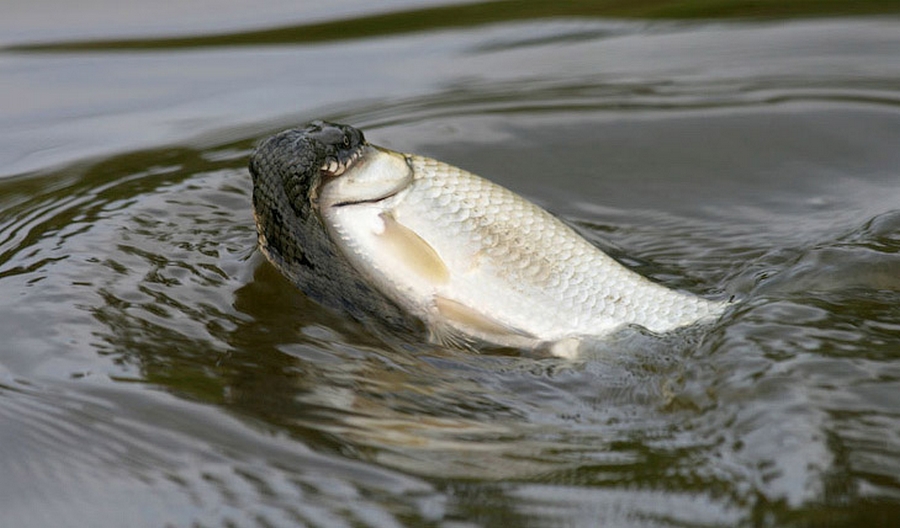
Something like this is happening every time someone sees me catching or taking pictures of water snakes.
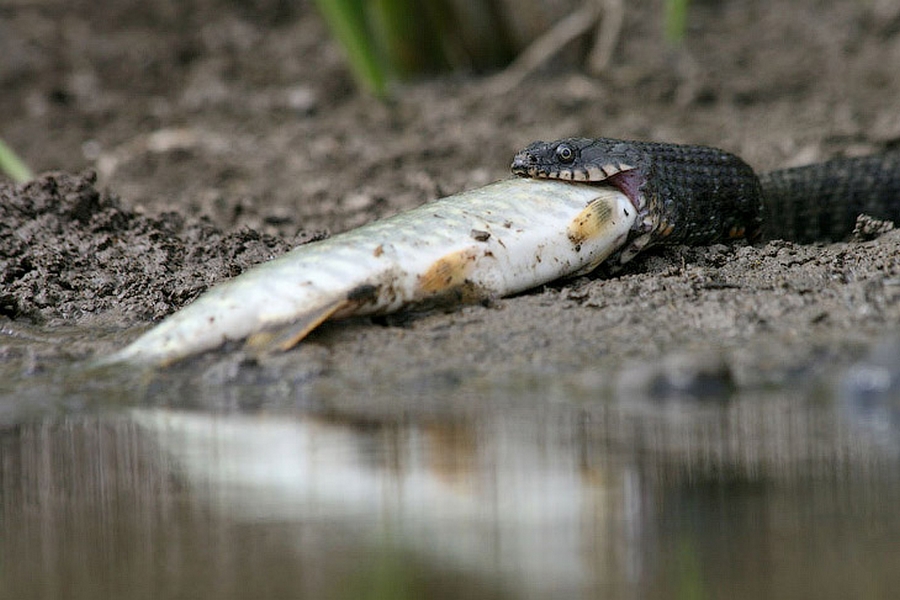
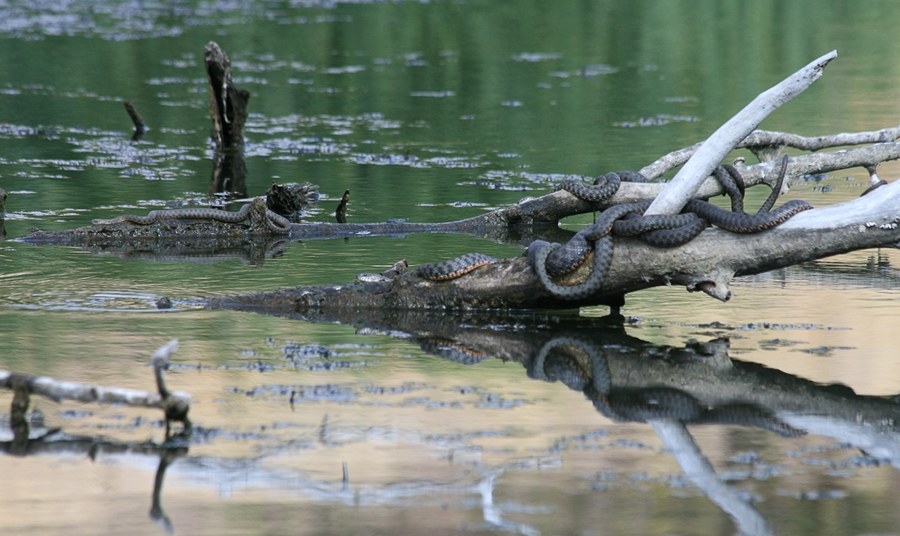
The notoriety of these snakes is only the fruit of fear of people who are not familiar with the reptiles. Water snakes are devoid of the characteristic sign of a non-venomous snake, familiar to everyone - yellow-orange spots in the back of the head, which the common snake (Natrix natrix) has. For this reason, ignorant people of all snakes without such spots are referred to as vipers and are considered poisonous and dangerous. Many divide all legless reptiles into snakes and simply “snakes”, meaning vipers. So they say: "Is this really a snake?"


As soon as they do not call water snakes: "a hybrid of a viper and a snake", "a chess viper", "chess". When shouting “a chess serpent” on the beach, the swimmers jump out of the water and wait for the snake to swim away, or until there is a “daredevil” and kill the snake with a stick. We often hear fishermen tell stories about “meter vipers” swimming across rivers or climbing into cages with fish.
All these stories are not really related to vipers, they are about water snakes. The species name of the grassland N. tessellata is indeed translated from Latin as chess, but it has nothing to do with water vipers. He belongs to the genus perishing (Natrix sp.) As well as ordinary perishing.
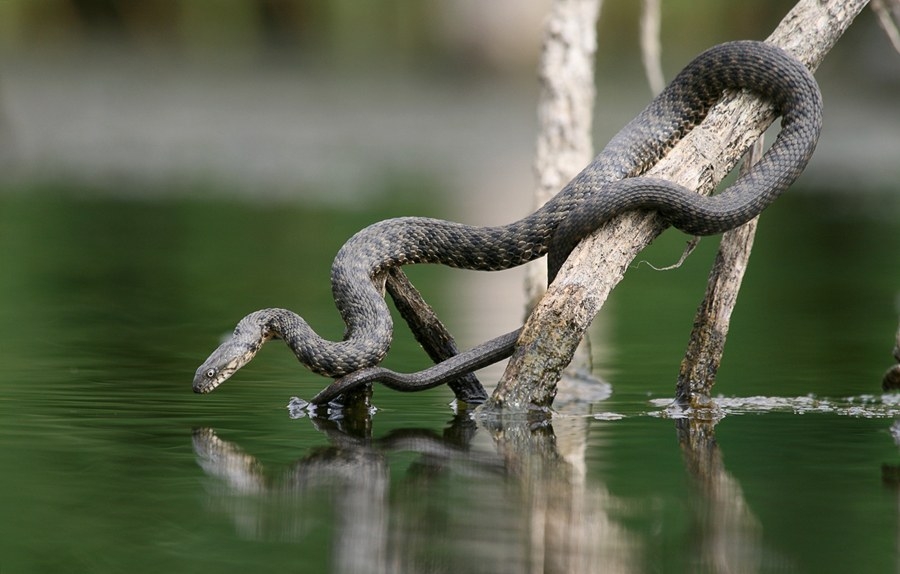
For a person, watermelon is harmless. The snake's defenses are loud hiss and fetid excrement released at danger. In contrast to the ordinary horror, water practically never pretends to be dead.
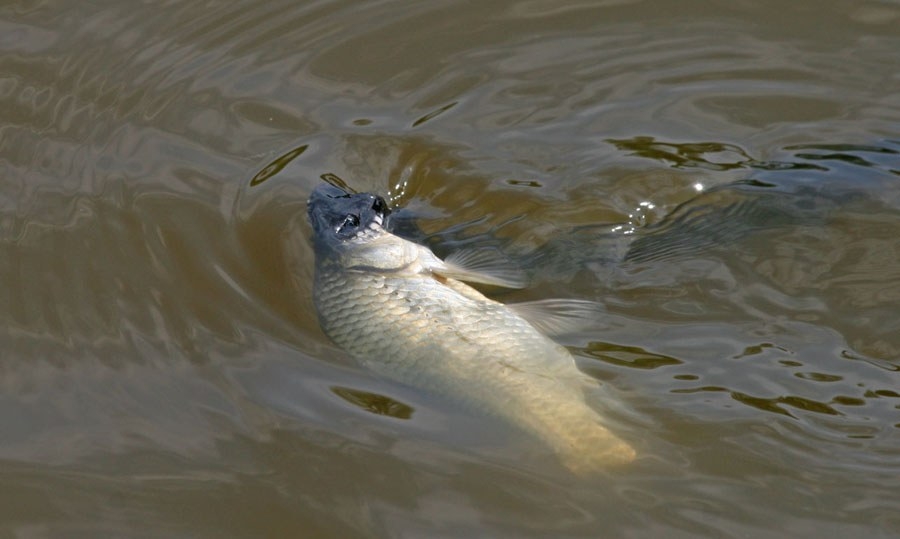
The main food of water snakes is the fish that they catch among aquatic plants, snags or trapping, lying on the bottom. The snake can not swallow caught prey under water, so it rushes to the shore, where it swallows the fish, having previously turned its head towards itself.
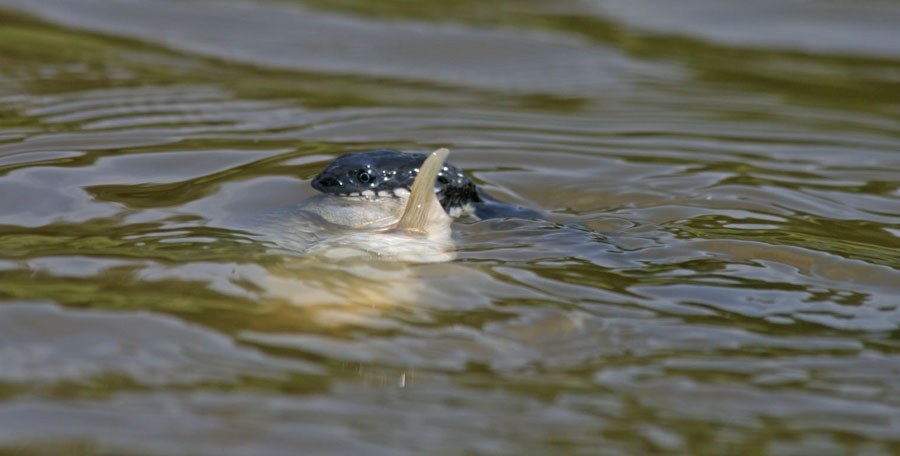
If the prey is too large, the meal may take an hour or more. Some snakes die without calculating the strength and choosing too large fish.
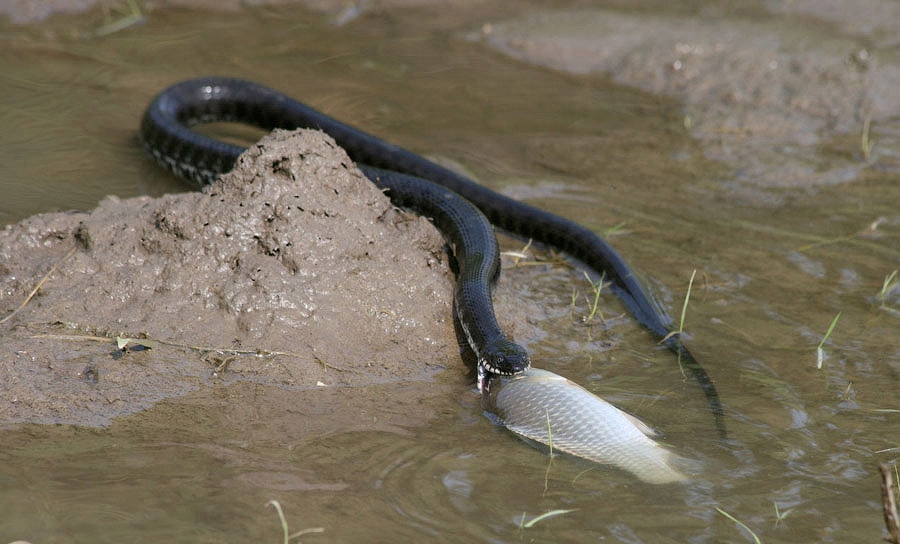
“Water is widespread quite widely: from southwestern France, the valley of the r. The Rhine in the west, the southern boundary of the range passes through the eastern part of northern Africa (to the Persian Gulf, Pakistan), in the east it occurs to the north-west of China, and the northern limits of the territory pass through the Volga-Kamsky region, ”says Ph.D. Volgograd State University, herpetologist Dmitry Gordeev.
“This species belongs to the class of reptiles (Reptilia), the order of the serpent (Serpentes), the family of the colony (Colubridae), the genus of the present snake (Natrix) and the species of water snake (Natrix tessellata). Water spirits are relatively large, not poisonous, like all members of this family,. Moreover, females, as a rule, are longer than males and can grow up to 1.1 m. Despite its impressive size, it is somewhat smaller than our usual and easily recognizable ordinary snake, which can reach up to 1.14 m.

The muzzle of the water snake, in comparison with the ordinary one, is more pointed, and there are no yellow-orange spots on the sides of the head. Because of the latter circumstance, he is often confused with such venomous snakes, like the common viper and the steppe viper. "Oil to the fire" adds a pattern on the back of a water snake, which vaguely resembles a zigzag strip of vipers. I have repeatedly come across dead snakes, which, apparently, the local population took for poisonous and mercilessly destroyed. In one of the expeditions I met the place of “mass execution”, where I counted 25 killed “chess vipers”.
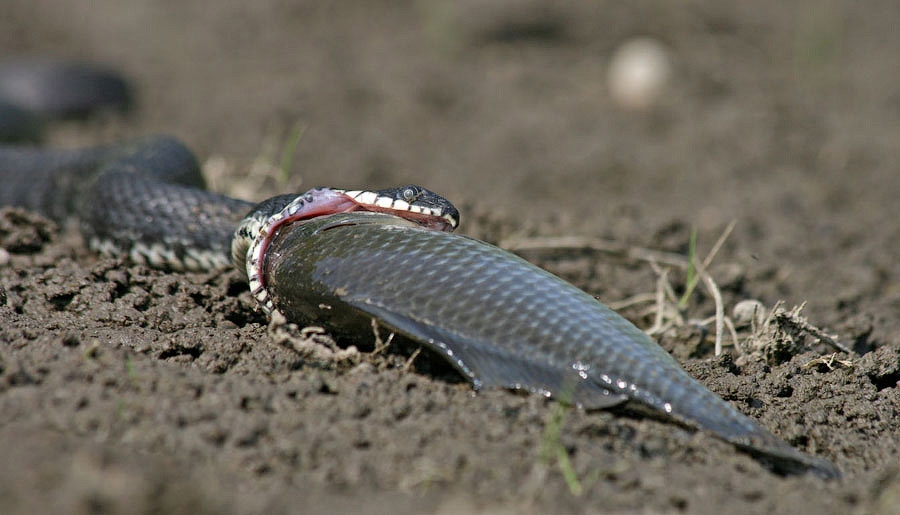
However, water already has a number of external signs by which it can be easily distinguished from poisonous vipers. The head is most recognizable - it has a triangular shape in vipers and most of the scales (scales) on it are small, whereas in water snakes it is oval, and all of them are large. If you take courage and look at the snake in the eye, you can see that in vipers, like real predators, the pupil is vertical (like a cat), and in a snake - round. In addition, vipers are much smaller than snakes: the largest common adder reaches a length of up to 0.73 m.
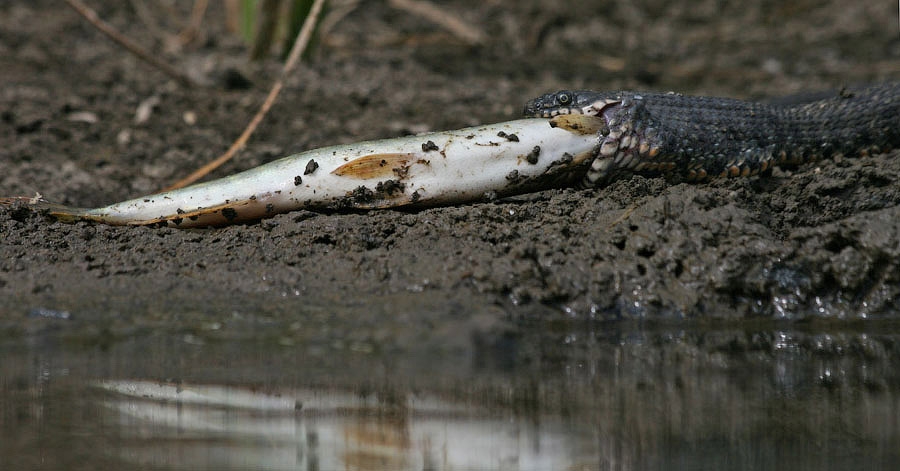
Water already settles near the water: along the banks of rivers and irrigation canals, in flood plains, where it finds food for itself. Despite its peace-loving nature, it is an active predator. Prefers fish different types - perch, roach, loach, can even hunt pike. Therefore, scientists call it an ichthyophage. Caught prey snake pulls ashore, where he eats. Much less frequently in the diet includes frogs and their tadpoles.
In the literature there is information about the discovery in the stomach of even a baby of an ordinary viper! The size of the victim can exceed the size of the snake's head, and a mobile connection of the lower jaws and some bones connected with them helps to swallow it. Swallowing occurs by alternately moving the left and then the right half of the lower jaw. This creates the impression that the snake "crawls" on its prey.

The active season lasts almost 9 months, appearing from winter shelters in April. Soon after mating begins, then snakes are found in large numbers. One female can lay from 4 to 20 eggs, of which in July, under favorable circumstances, young animals will appear. Asylum for them are reed beds, tree roots, substrate crevices, rodent burrows, stumps and snags. Wintering is spent at the end of October in large groups, sometimes together with an ordinary snake. They hunt for hedgehogs, desmans, muskrats, foxes, some birds: osprey, gray heron, hawks, snake eater, crow, rook, and some others. ”
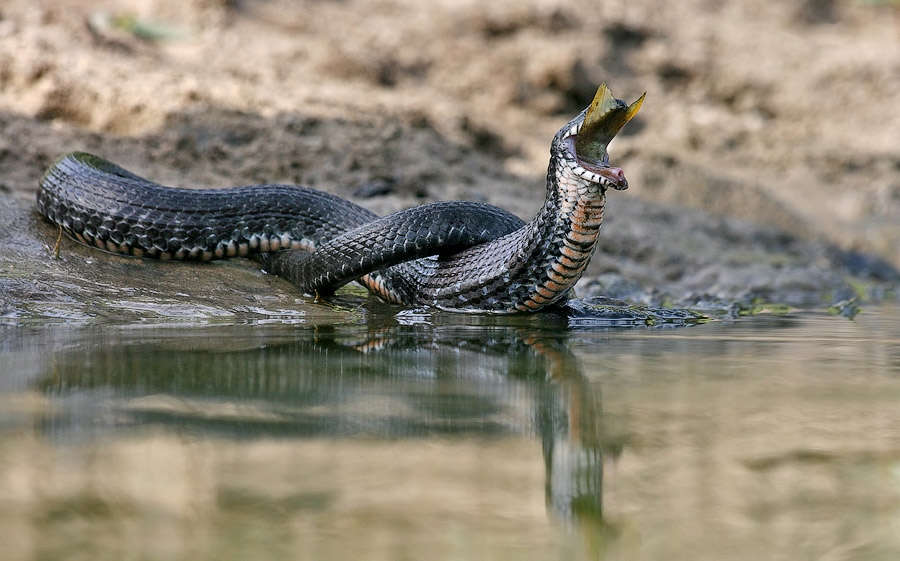
Every time when I hear references to “terribly poisonous chess”, I tell about water snakes, their way of life, I try to convince that these snakes are absolutely not dangerous. But every time I encounter confusion, it is easier for people to be afraid of the “chess viper” than to admit their belief in rumors and stop killing all the snakes that are deprived of the “identifying marks” of the ordinary snake.
Water Already - Natrix tesselata (Laurenti, 1768) Order Scaled Squamata Suborder Serpentes Snakes Family Terrestrial Colubridae Status Category 4 type, undefined by status. Currently, sufficient information about the state in nature is missing. International status. Protected by the Berne Convention.From South-West France, eastern North. Africa through Europe, Small, Front and Central Asia to the Persian Hall. and Pakistan. The area covers the Black Sea coast, the Crimea, the entire Caucasus and Transcaucasia, Kazakhstan. The species extends to the eastern border of the European part of Russia. In the Voronezh region. water snake melanistic color found on the left bank and the right bank of the river. Bityug in the env. x Serov in 1996, 2002 and 2004
Large snake with a body length of up to 140 cm and about 56 times shorter tail. The length of the males is 80 cm, females 98 cm. The muzzle is pointed. On the upper side of the body there are dark spots, arranged in a checkerboard pattern or in the form of narrow transverse stripes. Monotonous individuals are frequent, without a pattern. There are also full melanists.
Water already closely associated with water, lives near flowing and standing water bodies. He loves cliffs and stony slopes along the banks of rivers and streams, floodplain lakes, oxbows and swamps, reed beds, swamplands near springs.
During the whole season, snakes are active during the day, most of the time is spent in the water. They feed mainly on fish, as well as on frogs, tadpoles, small rodents and birds. In the spring appear on the surface in March-April. Mating occurs throughout April.
In the summer, at the end of June and early July, the female water snake lays from 4 to 18 eggs. By the end of summer or early September, young snakes appear, their body length (without tail) is 14,018.5 cm. The activity of the snakes stops with the onset of cold weather in October-November.
The number and trends of its change. Unknown.
Limiting factors. Lack of suitable reservoirs.
Accepted and necessary security measures. The organization of protected areas in key habitats of the species in which its presence is established is required.
Information sources: The determinant of amphibians ... 1977; Amphibians and reptiles ... 1998; Tkachenko, 2004. Compilers: S. V. Repitunov, A. I. Masalykin; photo: S.V. Smirnov.
Unlike ordinary snake (lat. Natrix natrix), water already has no characteristic orange-yellow temporal spots. In their place there is a ^ -shaped black spot, which is pointed at the top forward. Its color is, as a rule, olive with stained dark spots. Occasionally monophonic olive or even black individuals are found. The size of the water snake is up to 1.6 m, but usually 1-1.3 m. Females are larger than males. Scales of the body strongly keeled, around the middle of the body 19 scales. Subtail tails are whole.
It is strongly associated with water bodies (both salty and fresh), where it spends much more time than the ordinary one. It feeds mainly on fish (60%), less often amphibians. Spends the night on land, in the morning it warms up in the sun and goes into the water to hunt. Catching prey, crawls back to the shore, where it swallows it and either goes for a new fish, or gets ready to digest prey. Azov and Crimean estuaries often hunt gobies, for which he received the nickname “bychkolov”. It also hibernates on land, spring appears in March-April, mating season in April-May. Egg-laying. Juveniles appear in July-August. Wintering takes place in October-November. The main enemies of the snake are birds of prey and mammals, as well as pike, a number of snakes (for example, olive and patterned snakes) and some others.
The water one is non-aggressive, at the sight of a man he usually tries to hide in the water or in the shelter. Bites are extremely rare. For the person practically does not represent any danger. However, this does not prevent the local population and tourists from actively exterminating water snakes, calling them "chess vipers" or "hybrids of the snake and the viper" and mistakenly considering them poisonous. The stories about allegedly real cases of poisoning as a result of a water snake bite are, for the most part, apparently the result of the inability of most people to distinguish a water snake from an ordinary viper. Cases of wound infection are practically impossible, since saliva has bactericidal properties.
Water is widespread throughout Southern Europe, in the southern regions of Russia and Ukraine (Don, Volga, Kuban, Black and Azov seas, estuaries), as well as in Transcaucasia and Central Asia. In general, it is more southerly than an ordinary one.
Wikimedia Foundation. 2010
With the arrival of autumn, one often hears from traveling to rest "on nature" or on the Astrakhan dacha about the accumulations of terrible snakes - "chess". Many people mistakenly believe that they are poisonous vipers and are striving to destroy them without fail. So who do they really see? This is our today's story.
Oh, ordinary has on the head characteristic yellow spots
Snakes are astounding and mysterious creatures. The shape of their bodies, the characteristics of movement, the ability to update the cover - all this is fascinating and can not but amaze! In the Astrakhan region there are several species of snakes, the most famous of which are venomous vipers and non-poisonous snakes. It should be noted that the vipers live mainly in the northern regions of the Astrakhan region, where steppe landscapes prevail and practically do not occur in the delta flooded during the flood period. Harmless snakes, on the contrary, live in the Astrakhan region everywhere, they can be seen almost everywhere. However, there is a popular belief that snakes are only those snakes with two bright yellow or orange spots on their heads. Indeed, this is a distinctive feature of ordinary grass snake (Natrix natrix), which, thanks to the school biology course, almost all adults and children easily recognize.

The typical coloring of the water already defined its popular name - “chess”
Another member of the family of the snake-shaped one - the water snooker (Natrix tessellata) was less fortunate. At the sight of this rather large reptile, the length of which can reach 1.5 meters, people somehow remember the viper, therefore they are often called the “chess viper” or simply the “chess player” and, guided by the principle “the best defense is attack”, they try to kill her. Nevertheless, the water snake is not poisonous and, despite its terrible appearance, it is absolutely not dangerous for humans. At the sight of danger snakes usually try to hide in the water or in the shelter. If you can not flee, you can still try to pretend to be dead, or imitate an attack. Apparently cases of aggressive behavior of water snakes and gave rise to the folk myth about their relationship to vipers.
The easiest way to distinguish a viper from a grass snake is by its pupil: all pupillary pupils are round, while vipers have a vertical pupil. The color of water snakes is quite diverse. The most common individuals are the upper body of which is olive, olive-gray, greenish-brown or almost black with staggered dark spots or narrow transverse stripes. Behind the head there is usually a characteristic dark spot in the form of two strips converging at an acute angle on the nape. The underside is white, yellowish, pink-red or orange-red, with transverse dark spots of various sizes, sometimes merging with one another. Often there are monochrome, completely black copies.

Already swallows whole prey
The water body lives on the shores of various reservoirs, swims and dives perfectly, and is able to make distant migrations from the reservoir to the reservoir by land. It feeds mainly on fish that it catches under water. Very often she climbs into the fishing grounds in the hope of profit from someone else's catch, or swallows fish caught on hooks of anglers. Minor food - frogs and toads, as well as small rodents and occasionally birds. Eating prey entirely and alive, gradually swallowing, settling down in a secluded place.
There are no venomous snakes on the territory of the Astrakhan Biosphere Reserve. Mass snake species are so ordinary (Natrix natrix L., 1758) and so water(Natrix tessellata Laur., 1768), is found patterned snake(Elaphe dione Pall., 1773).
Patterned snake is one of the most widespread representatives of climbing snakes. It can reach a length of 1.2 - 1.5 meters. The color varies from brown and greenish to red and yellow, a characteristic feature are four longitudinal stripes stretching along the whole body, which are lighter than the main background color. The ration of the patterned snake includes small mammals, birds, snakes, amphibians, fish and insects. Eats eggs and chicks from bird clutches. The egg swallows whole, the shell crushes the lower processes of the vertebrae, pressing them against the wall of the esophagus. The snake, caught by live prey, is first stifled, squeezing its body with rings, and swallows only the dead one, starting from the head, after having been wetted with saliva. Recently, often found in the lower reaches of the Volga. The snake is not poisonous and harmless to humans, but is very aggressive and can imitate an active attack, so considering its impressive size can seriously scare.
In this way, in the lower reaches of the Volga, a meeting with venomous snakes is unlikely , and for those who are going to the northern districts of the Astrakhan region (Saray-Batu, Mount Bogdo), we offer useful information on how to distinguish the viper from the snake.
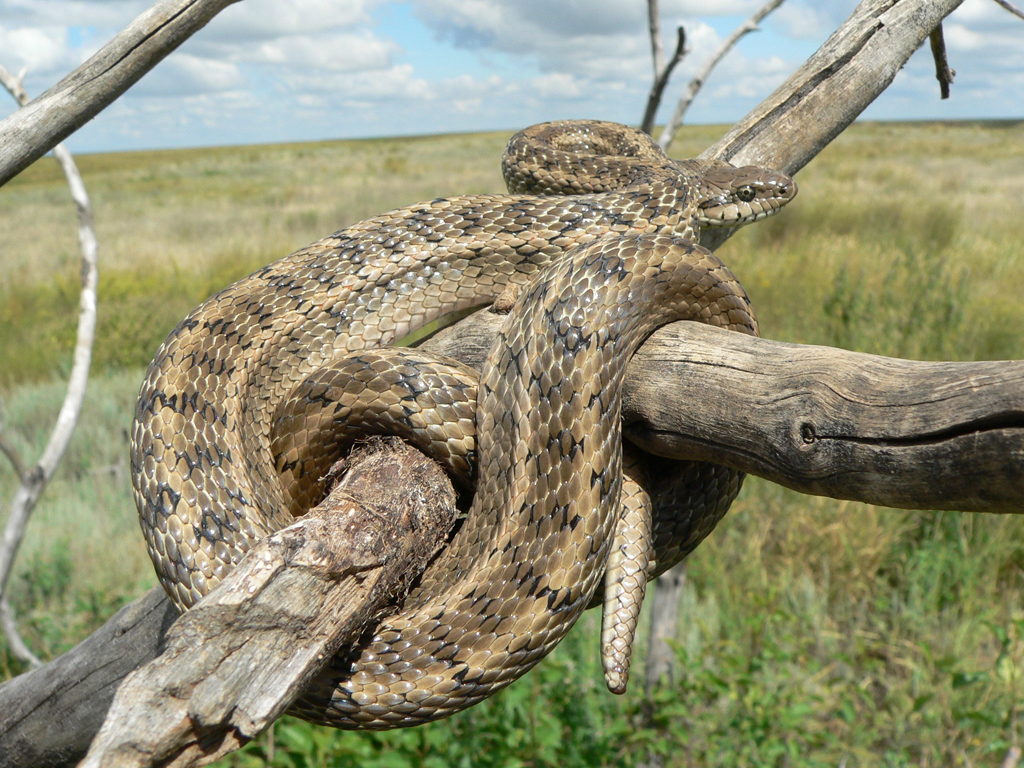
Patterned snake climbs trees perfectly
And remember a few rules for handling snakes in nature, which will save your nerves and the life of reptiles:
1. Snakes, even venomous, never attack a person first, but only for self-defense, if you step on it or take it by surprise. Therefore, if you notice a snake, do not try to catch it, chase or kill it and it will quietly disappear. In places where snakes can meet, try not to move silently - having heard your steps, the snake will crawl away, and you will not even know that it was nearby.
2. If the snake crawled into the house, tent or on the dacha, try to determine how dangerous it is (about the differences between the viper and the snake see above). If you are sure that the snake is not poisonous, then carefully remove it with the help of available tools. If there are fears that an uninvited guest may cause you serious trouble, it is better to call specialists, such as rescuers. You can use special devices, for example, vibration or infrasonic repellents, which can be purchased in specialized stores. The principle of operation of repellers is based on the fact that the infrasound or vibration distributed by them causes discomfort among reptiles caught in the field of action, which causes them to crawl to a safe distance.
3. If you were bitten by a snake, you do not need to panic. First, try to understand who bite you, because it can be a non-poisonous individual. Know that the bite of a poisonous snake leaves 2 strips of scratches on the skin with a puncture from the canines at the end of each strip. The bite of a non-venomous snake also leaves 2 scratches, only without punctures. Symptoms of a snakebite bite: the appearance of redness in the area of the bite, a large tumor appears around the wound, the state of health sharply worsens, headache, body temperature rises sharply, vomiting occurs in most cases. What to do? Call immediately ambulance or take the victim to a medical facility. In addition, even before the arrival of doctors, you can use the advice of an experienced herpetologist Mark Pestov. It is important to prevent the spread of poison from the bloodstream, so the bitten limb must lie motionless, and the victim should move less so that the blood in the body circulates as slowly as possible. It is also useful to drink as much water as possible, so that a part of toxic decomposition products leaves the body naturally. You can take antihistamine (anti-allergic) drugs, this will reduce the swelling.
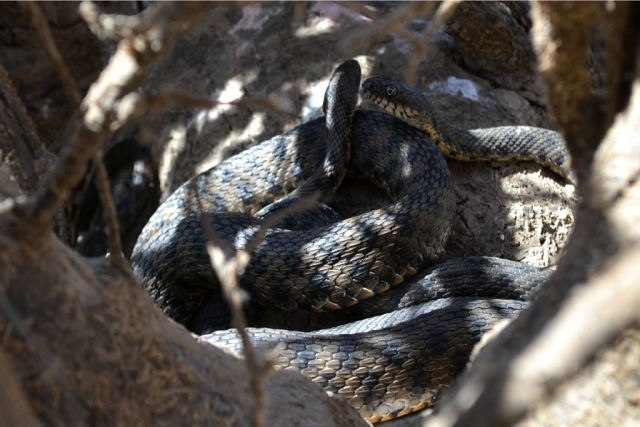
"Romance" snakelike
4. If you met a snake - do not kill her. Many nations of the world have old beliefs that prohibit depriving this animal of life, especially if it has fallen into a house. In some regions of Russia and Ukraine, vipers caught in a dwelling are considered to be home-grown and believe that they bring happiness and good. For many peoples, snakes are associated with the souls of their ancestors. Poles have a belief which says that every person has his own snake-twin, and therefore snakes cannot be killed. However, even if you do not pay attention to all existing signs and superstitions associated with snakes, you should remember that any snake is the same living thing as we, and it also has the right to life. Believe me, the snakes are much more afraid of us than we are of them, so you should not bring a meeting with them to an unpleasant incident, it is better to give way to them and not attract attention. Take care of snakes!
N.V. Fur - Ph.D., deputy director for environmental education of the Astrakhan Biosphere Reserve. Photo: Kashina A.A., Pestova M.V., Stebleva A.V.
This is an informative article about water snakes, in a shortened form, it was published in the November issue of National Geographic.

What are you taking a viper photograph, - I heard a voice behind my back, - Look, so as not to bite.
“No, not a viper, but a snake,” I replied, without looking up from the camera viewfinder and taking another close-up shot.
- Yes, the vipers now intersect with snakes: both black and gray, and in the box, and all terribly poisonous!

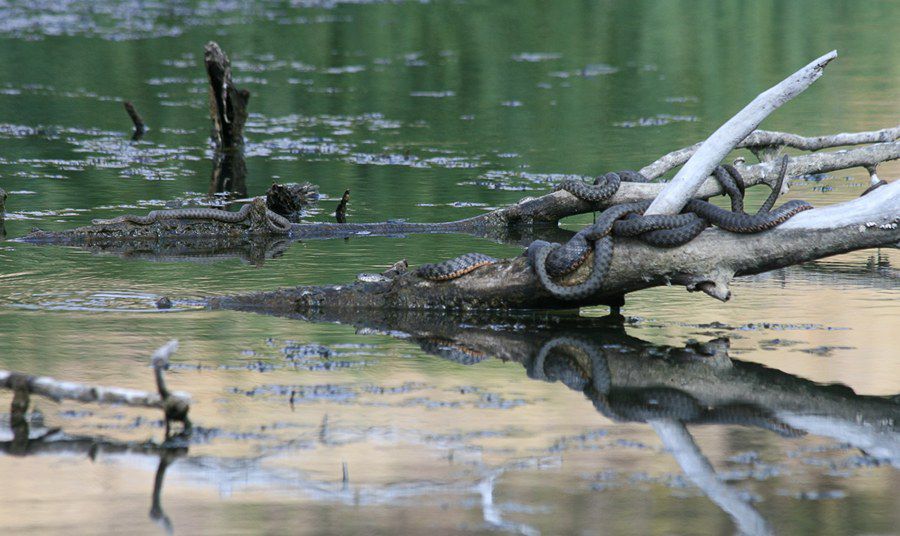
Approximately this dialogue happens every time someone sees me catching or photographing water snakes (Natrix tessellata).
![]()
The notoriety of these snakes is only the fruit of fear of people who are not familiar with the reptiles. Water snakes are devoid of the characteristic sign of a non-venomous snake, familiar to everyone - yellow-orange spots in the back of the head, which the common snake (Natrix natrix) has. For this reason, ignorant people of all snakes without such spots are referred to as vipers and are considered poisonous and dangerous. Many divide all legless reptiles into snakes and simply “snakes”, meaning vipers. So they say: "Is this really a snake?"
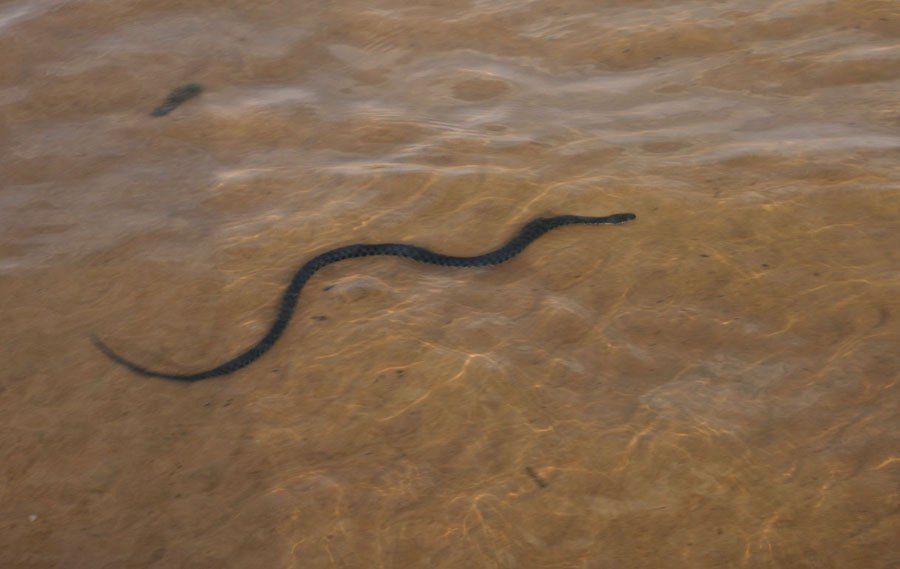
As soon as they do not call water snakes: "a hybrid of a viper and a snake", "a chess viper", "chess". When shouting “a chess serpent” on the beach, the swimmers jump out of the water and wait for the snake to swim away, or until there is a “daredevil” and kill the snake with a stick. We often hear fishermen tell stories about “meter vipers” swimming across rivers or climbing into cages with fish.
All these stories are not really related to vipers, they are about water snakes. The species name of the grassland N. tessellata is indeed translated from Latin as chess, but it has nothing to do with water vipers. He belongs to the genus perishing (Natrix sp.) As well as ordinary perishing.
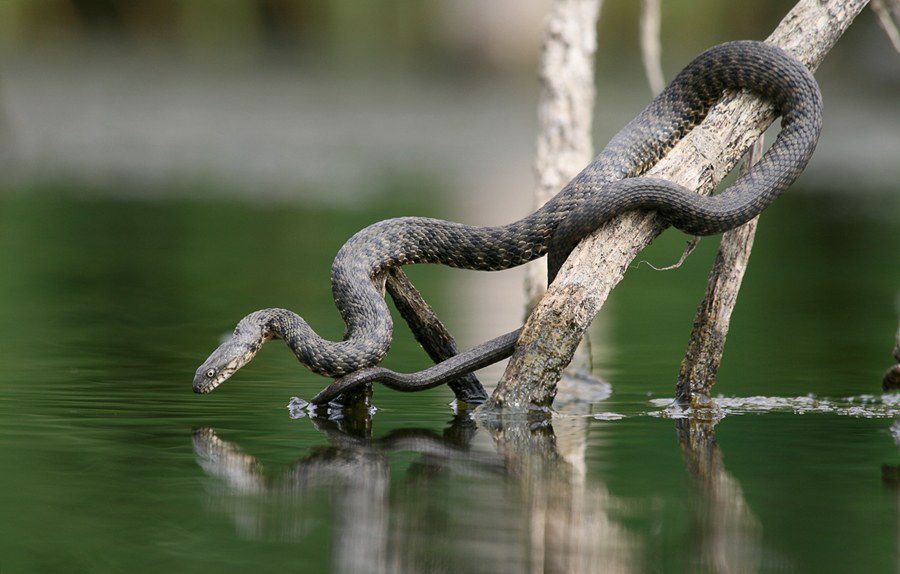
For a person, watermelon is harmless. The snake's defenses are loud hiss and fetid excrement released at danger. In contrast to the ordinary horror, water practically never pretends to be dead.
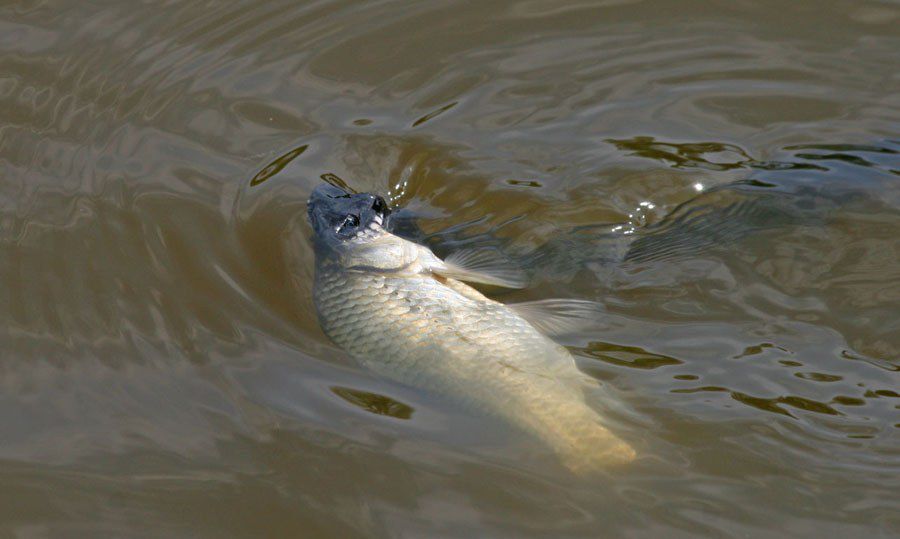
The main food of water snakes is the fish that they catch among aquatic plants, snags or trapping, lying on the bottom. The snake can not swallow caught prey under water, so it rushes to the shore, where it swallows the fish, having previously turned its head towards itself.

If the prey is too large, the meal may take an hour or more. Some snakes die without calculating the strength and choosing too large fish.
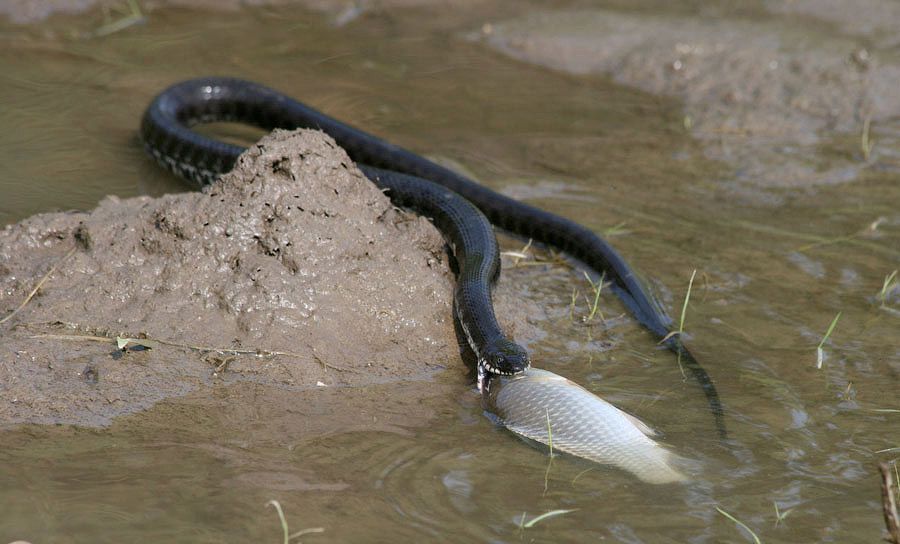
“Water is widespread quite widely: from southwestern France, the valley of the r. The Rhine in the west, the southern boundary of the range passes through the eastern part of northern Africa (to the Persian Gulf, Pakistan), in the east it occurs to the north-west of China, and the northern limits of the territory pass through the Volga-Kamsky region, ”says Ph.D. Volgograd State University, herpetologist Dmitry Gordeev.
“This species belongs to the class of reptiles (Reptilia), the order of the serpent (Serpentes), the family of the colony (Colubridae), the genus of the present snake (Natrix) and the species of water snake (Natrix tessellata). Water moth is a relatively large non-poisonous snake, like all members of this family. Moreover, females, as a rule, are longer than males and can grow up to 1.1 m. Despite its impressive size, it is somewhat smaller than our usual and easily recognizable ordinary snake, which can reach up to 1.14 m.
The muzzle of the water snake, in comparison with the ordinary one, is more pointed, and there are no yellow-orange spots on the sides of the head. Because of the latter circumstance, he is often confused with such venomous snakes, like the common viper and the steppe viper. "Oil to the fire" adds a pattern on the back of a water snake, which vaguely resembles a zigzag strip of vipers. I have repeatedly come across dead snakes, which, apparently, the local population took for poisonous and mercilessly destroyed. In one of the expeditions I met the place of “mass execution”, where I counted 25 killed “chess vipers”.
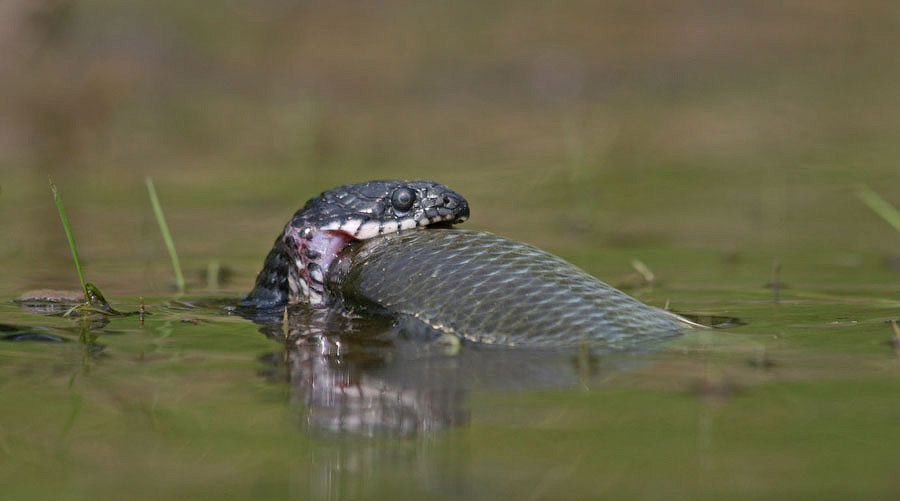
However, water already has a number of external signs by which it can be easily distinguished from poisonous vipers. The head is most recognizable - it has a triangular shape in vipers and most of the scales (scales) on it are small, whereas in water snakes it is oval, and all of them are large. If you take courage and look at the snake in the eye, you can see that in vipers, like real predators, the pupil is vertical (like a cat), and in a snake - round. In addition, vipers are much smaller than snakes: the largest common adder reaches a length of up to 0.73 m.

Water already settles near the water: along the banks of rivers and irrigation canals, in flood plains, where it finds food for itself. Despite its peace-loving nature, it is an active predator. Prefers fish of different species - perch, roach, loach, can even hunt for pike. Therefore, scientists call it an ichthyophage. Caught prey snake pulls ashore, where he eats. Much less frequently in the diet includes frogs and their tadpoles.
In the literature there is information about the discovery in the stomach of even a baby of an ordinary viper! The size of the victim can exceed the size of the snake's head, and a mobile connection of the lower jaws and some bones connected with them helps to swallow it. Swallowing occurs by alternately moving the left and then the right half of the lower jaw. This creates the impression that the snake "crawls" on its prey.
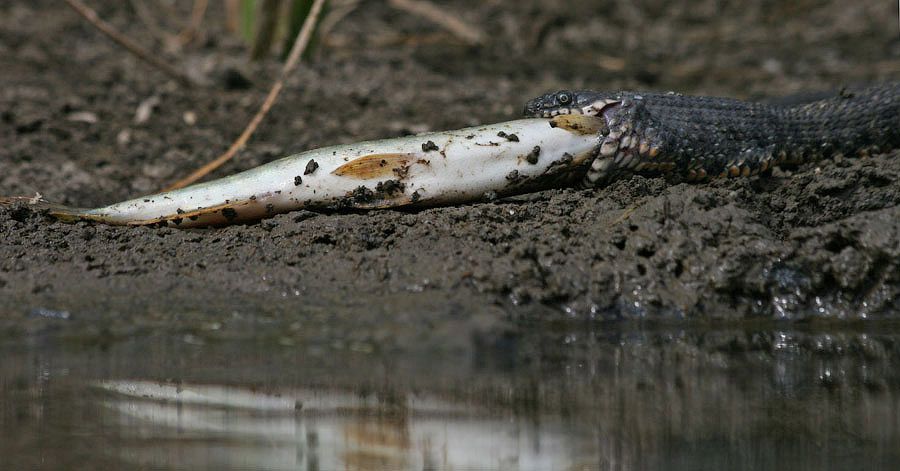
The active season lasts almost 9 months, appearing from winter shelters in April. Soon after mating begins, then snakes are found in large numbers. One female can lay from 4 to 20 eggs, of which in July, under favorable circumstances, young animals will appear. Asylum for them are reed beds, tree roots, substrate crevices, rodent burrows, stumps and snags. Wintering is spent at the end of October in large groups, sometimes together with an ordinary snake. They hunt for hedgehogs, desmans, muskrats, foxes, some birds: osprey, gray heron, hawks, snake eater, crow, rook, and some others. ”
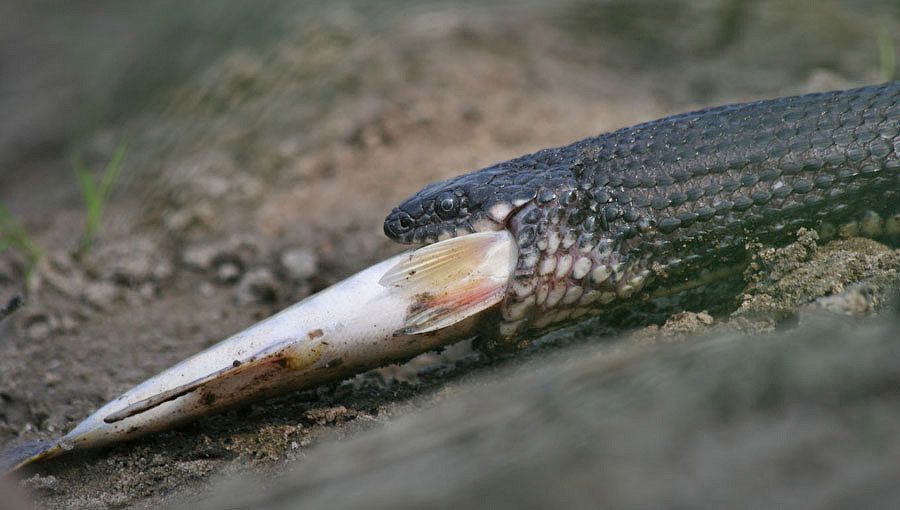
Every time when I hear references to “terribly poisonous chess”, I tell about water snakes, their way of life, I try to convince that these snakes are absolutely not dangerous. But every time I encounter confusion, it is easier for people to be afraid of the “chess viper” than to admit their belief in rumors and stop killing all the snakes that are deprived of the “identifying marks” of the ordinary snake.
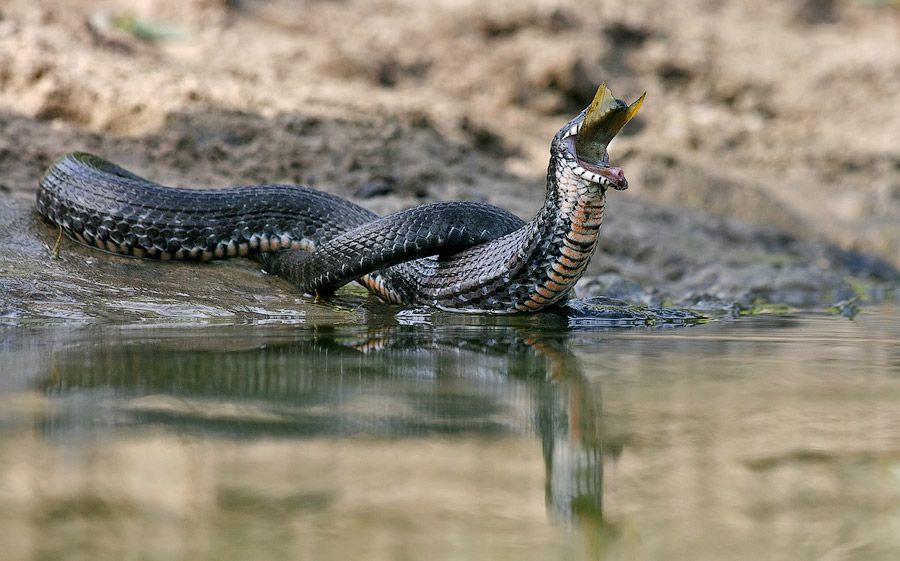
| Related articles: | |
|
Cabbage salad with carrots "Maximum of vitamins
The problem of proper nutrition today is most acute. If before ... Modern embroidery in the interior becomes a fashionable trend of design. Modern embroidery in the interior becomes a fashionable trend of design.
When it comes to embroidery, a sort of Russian appears before your eyes ... The best snack for weight loss
Eating right means not only watching you eat on ... | |